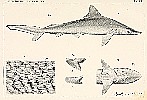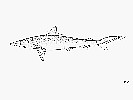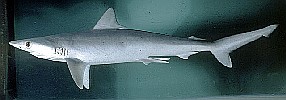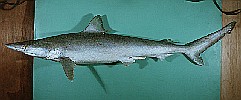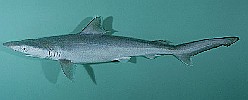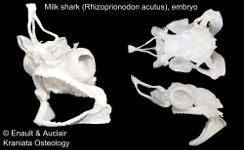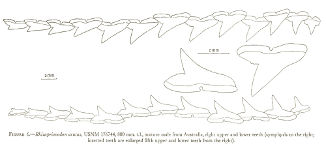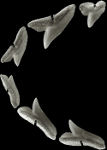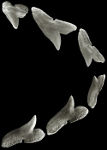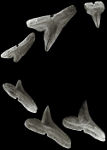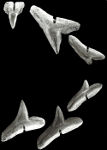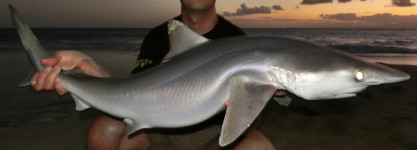Rhizoprionodon acutus
(Rüppell, 1837)
Milk shark
Classification: Elasmobranchii Carcharhiniformes Carcharhinidae
Reference of the original description
Neue Wirbelthiere zu der Fauna von Abyssinien gehörig: Fische des rothen Meeres. Frankfurt am Main, 1837: pp. 53–80, pls. 15–21
Neue Wirbelthiere zu der Fauna von Abyssinien gehörig: Fische des rothen Meeres. Frankfurt am Main, 1837: pp. 53–80, pls. 15–21
Image of the original description
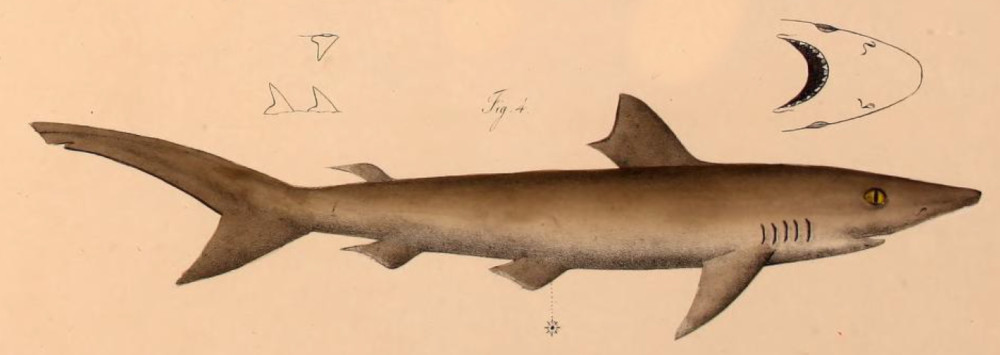
Rhizoprionodon acutus (Rüppell, 1837), image of the first description in Rüppell, plate 18, fig. 4

Rhizoprionodon acutus (Rüppell, 1837), image of the first description in Rüppell, plate 18, fig. 4
Synonyms / new combinations and misspellings
Carcharhinus (Scoliodon) acutus, Carcharias aaronis, Carcharias acutus, Carcharias crenidens, Carcharias eumeces, Carcharias sorrahkowah, Carcharias walbeehmi, Carcharias walbeehmii, Carcharias walbenii, Carcharias (Prionodon) sorrahkowah, Carcharias (Scoliodon) acutus, Carcharias (Scoliodon) crenidens, Carcharias (Scoliodon) walbeehmi, Carcharinus acutus, Carcharinus walbeehmi, Hypoprion acutus, Protozygaena longmani, Rhizoprion crenidens, Rhizoprionodon aff. acutus, Rhizoprionodon cf. acutus, Rhizoprionodon crenidens, Rhizoprionodon (Rhizoprionodon) acutus, Scoliodon acutus, Scoliodon longmani, Scoliodon sorrakawah, Scoliodon sorrakowa, Scoliodon sorrakowah, Scoliodon vagatus, Scoliodon wahlbeehmi, Scoliodon walbeehmi, Scoliodon walbeehmii, Scoliodon walbeemii, Squalus (Scoliodon) acutus
Carcharhinus (Scoliodon) acutus, Carcharias aaronis, Carcharias acutus, Carcharias crenidens, Carcharias eumeces, Carcharias sorrahkowah, Carcharias walbeehmi, Carcharias walbeehmii, Carcharias walbenii, Carcharias (Prionodon) sorrahkowah, Carcharias (Scoliodon) acutus, Carcharias (Scoliodon) crenidens, Carcharias (Scoliodon) walbeehmi, Carcharinus acutus, Carcharinus walbeehmi, Hypoprion acutus, Protozygaena longmani, Rhizoprion crenidens, Rhizoprionodon aff. acutus, Rhizoprionodon cf. acutus, Rhizoprionodon crenidens, Rhizoprionodon (Rhizoprionodon) acutus, Scoliodon acutus, Scoliodon longmani, Scoliodon sorrakawah, Scoliodon sorrakowa, Scoliodon sorrakowah, Scoliodon vagatus, Scoliodon wahlbeehmi, Scoliodon walbeehmi, Scoliodon walbeehmii, Scoliodon walbeemii, Squalus (Scoliodon) acutus
Types
Rhizoprionodon acutus
Lectotype: SMF: 2783; Paralectotype: SMF: 761;
Carcharias aaronis
Syntype: ZMB: 4453 ZMB: 2261 ZMB: 4456
Carcharias eumeces
Holotype: MW: PI 2; Paratype: NMW: 61212;
Carcharias (Prionodon) sorrahkowah
XXXX: No types known;
Carcharias (Scoliodon) crenidens
Holotype: SMNS: 2449;
Scoliodon longmani
Holotype: QM: I.292;
Scoliodon vagatus
Holotype: MCZ: 401-S
Rhizoprionodon acutus
Lectotype: SMF: 2783; Paralectotype: SMF: 761;
Carcharias aaronis
Syntype: ZMB: 4453 ZMB: 2261 ZMB: 4456
Carcharias eumeces
Holotype: MW: PI 2; Paratype: NMW: 61212;
Carcharias (Prionodon) sorrahkowah
XXXX: No types known;
Carcharias (Scoliodon) crenidens
Holotype: SMNS: 2449;
Scoliodon longmani
Holotype: QM: I.292;
Scoliodon vagatus
Holotype: MCZ: 401-S
Description :
Citation: Rhizoprionodon acutus (Rüppell, 1837): In: Database of modern sharks, rays and chimaeras, www.shark-references.com, World Wide Web electronic publication, Version 12/2025
Please send your images of "Rhizoprionodon acutus" to info@shark-references.com
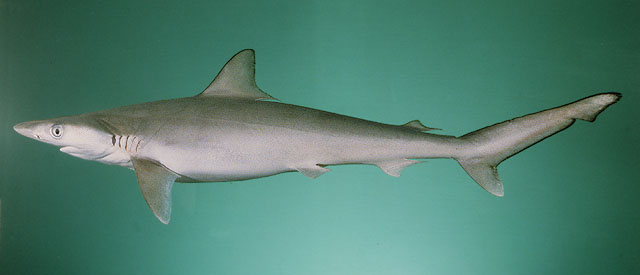
Rhizoprionodon acutus (Rüppell, 1837), © Randall, J.E, www.fish-base.org

Rhizoprionodon acutus (Rüppell, 1837), © Randall, J.E, www.fish-base.org
Common names
 Cazón lechero,
Cazón lechero,  Cazón lechoso,
Cazón lechoso,  Cazón picudo,
Cazón picudo,  Marajo,
Marajo,  Lézard,
Lézard,  Requin à museau pointu,
Requin à museau pointu,  Requin à nez pointu,
Requin à nez pointu,  Blacktip shark,
Blacktip shark,  Fish shark,
Fish shark,  Grey dog shark,
Grey dog shark,  Grey dog-shark,
Grey dog-shark,  Little blue shark,
Little blue shark,  Longmans dogshark,
Longmans dogshark,  Milk dog shark,
Milk dog shark,  Milk shark,
Milk shark,  Milkshark,
Milkshark,  Sharp nosed shark,
Sharp nosed shark,  Sharp-nosed milk shark,
Sharp-nosed milk shark,  Walbeehm"s sharp-nosed shark,
Walbeehm"s sharp-nosed shark,  White-eye shark,
White-eye shark,  Yellow dog shark,
Yellow dog shark,  Squalo latteo,
Squalo latteo,  Marracho branco,
Marracho branco,  Tubarão-bicudo
Tubarão-bicudo
 Cazón lechero,
Cazón lechero,  Cazón lechoso,
Cazón lechoso,  Cazón picudo,
Cazón picudo,  Marajo,
Marajo,  Lézard,
Lézard,  Requin à museau pointu,
Requin à museau pointu,  Requin à nez pointu,
Requin à nez pointu,  Blacktip shark,
Blacktip shark,  Fish shark,
Fish shark,  Grey dog shark,
Grey dog shark,  Grey dog-shark,
Grey dog-shark,  Little blue shark,
Little blue shark,  Longmans dogshark,
Longmans dogshark,  Milk dog shark,
Milk dog shark,  Milk shark,
Milk shark,  Milkshark,
Milkshark,  Sharp nosed shark,
Sharp nosed shark,  Sharp-nosed milk shark,
Sharp-nosed milk shark,  Walbeehm"s sharp-nosed shark,
Walbeehm"s sharp-nosed shark,  White-eye shark,
White-eye shark,  Yellow dog shark,
Yellow dog shark,  Squalo latteo,
Squalo latteo,  Marracho branco,
Marracho branco,  Tubarão-bicudo
Tubarão-bicudo
Short Description
Field Marks: In its area the only requiem shark with long upper and lower labial furrows, the first dorsal origin well behind the anal origin, and long preanal ridges. Key to species and diagnostic features give characters separating this from other, similar species in its genus.
Diagnostic Features: Prenarial snout 4 to 5.4% of total length; upper labial furrows long, 1.4 to 2% of total length; total count of enlarged hyomandibular pores on both sides of head just behind mouth angle usually over 16; teeth serrated in adults; teeth not well-differentiated between sexes; total tooth rows usually 25/24. First dorsal origin usually over or slightly in front of pectoral free rear tips; second dorsal origin ranges from above last third of anal base to over its insertion; pectoral anterior margin usually equal to or shorter than first dorsal length from origin to free rear tip. Posterior monospondylous precaudal centra greatly enlarged; precaudal centra usually less numerous than caudals (rarely the two are equal), precaudals 55 to 79, total centra 121 to 162. Size moderate, males maturing over 60 cm total length. Colour grey, grey-brown or purplish brown above, pale below, pectoral fins with a light margin. [517]
Field Marks: In its area the only requiem shark with long upper and lower labial furrows, the first dorsal origin well behind the anal origin, and long preanal ridges. Key to species and diagnostic features give characters separating this from other, similar species in its genus.
Diagnostic Features: Prenarial snout 4 to 5.4% of total length; upper labial furrows long, 1.4 to 2% of total length; total count of enlarged hyomandibular pores on both sides of head just behind mouth angle usually over 16; teeth serrated in adults; teeth not well-differentiated between sexes; total tooth rows usually 25/24. First dorsal origin usually over or slightly in front of pectoral free rear tips; second dorsal origin ranges from above last third of anal base to over its insertion; pectoral anterior margin usually equal to or shorter than first dorsal length from origin to free rear tip. Posterior monospondylous precaudal centra greatly enlarged; precaudal centra usually less numerous than caudals (rarely the two are equal), precaudals 55 to 79, total centra 121 to 162. Size moderate, males maturing over 60 cm total length. Colour grey, grey-brown or purplish brown above, pale below, pectoral fins with a light margin. [517]
Distribution
Eastern Atlantic: Madeira and Mauritania to Angola; reported from the Gulf of Taranto [20075]. Indo-West Pacific: Red Sea and East Africa to Indonesia, north to Japan, south to Australia. Source: www.gbif.org
Eastern Atlantic: Madeira and Mauritania to Angola; reported from the Gulf of Taranto [20075]. Indo-West Pacific: Red Sea and East Africa to Indonesia, north to Japan, south to Australia. Source: www.gbif.org
Human uses
fisheries: commercial; gamefish: yes
fisheries: commercial; gamefish: yes
Biology
Distinct pairing with embrace [17086]. Viviparous, with a yolk-sac placenta; 2 to 8 in a litter [544], usually 2 to 5 after a gestation period of ~ 12 months; no seasonality in the reproductive cycle [2539]. Size at birth between 25 and 39 cm.
Diet: 2015: [22757]: Arabian Gulf waters of the United Arab Emirates (database: 57 speciemens): fed on a wide variety of teleost species, primarily Engraulidae (anchovies) (28%), Gerreidae (mojarras) (5.6%) and Carangidae (jacks) (1.6%) with occasional crustacean and cephalopod prey (8%) Occurs on the continental shelf (Ref. 75154).
Distinct pairing with embrace [17086]. Viviparous, with a yolk-sac placenta; 2 to 8 in a litter [544], usually 2 to 5 after a gestation period of ~ 12 months; no seasonality in the reproductive cycle [2539]. Size at birth between 25 and 39 cm.
Diet: 2015: [22757]: Arabian Gulf waters of the United Arab Emirates (database: 57 speciemens): fed on a wide variety of teleost species, primarily Engraulidae (anchovies) (28%), Gerreidae (mojarras) (5.6%) and Carangidae (jacks) (1.6%) with occasional crustacean and cephalopod prey (8%) Occurs on the continental shelf (Ref. 75154).
Size / Weight / Age
175 cm TL (male/unsexed; [20067]); 80.8 cm TL (female); max. published weight: 5,000 g (Ref. 40637); max. reported age: 8 years [517]
175 cm TL (male/unsexed; [20067]); 80.8 cm TL (female); max. published weight: 5,000 g (Ref. 40637); max. reported age: 8 years [517]
Habitat
benthopelagic; amphidromous [17660]; freshwater; brackish; marine; depth range 1 - 200 m [517]
benthopelagic; amphidromous [17660]; freshwater; brackish; marine; depth range 1 - 200 m [517]
Dentition
Teeth in 13-1-13/11-1-11 series, those of both jaws with the inner border obliquely linear, the outer deeply notched (described from Scoliodon longmani = synonym of Rhizoprionodon acutus, holotype QM I.292) [11847];
Teeth in 13-1-13/11-1-11 series, those of both jaws with the inner border obliquely linear, the outer deeply notched (described from Scoliodon longmani = synonym of Rhizoprionodon acutus, holotype QM I.292) [11847];
Remarks
shark-references Species-ID=6097;
shark-references Species-ID=6097;
Parasites (arranged by Jürgen Pollerspöck)
Monogenea
Cestoda
Nematoda
Copepoda
Monogenea
- Loimos secundus Chauhan & Bhalerao, 1945 [17150]
Cestoda
- Anthobothrium laciniatum Linton, 1890 [16458]
- Anthobothrium samae Kamachali & Haseli, 2022 [32555]
- Anthobothrium shayani Kamachali & Haseli, 2022 [32555]
- Anthobothrium spinosum Subhapradha, 1955 [16423] [16423]
- Balanobothrium carchariasae Bhagwan & Shinde, 2002 [21460]
- Callitetrarhynchus gracilis (Rudolphi, 1819) Pintner, 1931 [16112] [15730] [21816]
- Hornelliella palasoorahi Zaidi & Khan, 1976 [16112]
- Nybelinia dighai Pramanik & Manna, 2006 [16375]
- Nybelinia indica Chandra, 1986 [16112]
- Nybelinia sp. [16112] [15730]
- Otobothrium australe Palm, 2004 [17826]
- Otobothrium carcharidis (Shipley & Hornell, 1906) [24083] [15730] [17826] [19555] [21816]
- Otobothrium minutum Subhapradha, 1955 [16423] [16112]
- Otobothrium sp. [15730]
- Phoreiobothrium arabiansi Shinde, Jadhav & Mohekar, 1984 [16167]
- Phoreiobothrium girjamami Shinde, Motinge & Pardeshi, 1993 [16405]
- Phoreiobothrium golchini Darvishi & Haseli, 2019 [27446]
- Phoreiobothrium jahki Caira & Jensen, 2015 [23548]
- Phoreiobothrium nadiae Caira & Jensen, 2015 [23548]
- Phoreiobothrium ratnagiriensis Shinde & Jadhav, 1987 [16394]
- Phoreiobothrium shindei Shinde, Jadhav & Jadhav, 1990 [16243]
- Phoreiobothrium swaki Caira & Jensen, 2015 [23548]
- Phoreiobothrium vinodae Jadhav, 1993 [16328]
- Phyllobothrium bombayensis Srivastava & Capoor, 1979 [16421]
- Platybothrium veravalensis Deshmukh, Shinde & Jadhav, 1977 [16300] [7384]
- Poecilancistrium caryophyllum (Diesing, 1850) Dollfus, 1929 [16112]
- Polypocephalus waltairensis Mote, 2012 [19910]
- Prochristianella aciculata Beveridge & Justine, 2010 [17404]
- Proemotobothrium southwelli Beveridge & Campbell, 2001 [15730]
- Pterobothrium acanthotruncatum Escalante & Carvajal, 1984 [16283] [16112]
- Scyphophyllidium musculosum (Subhapradha, 1955) [16423] [16423] [14437]
- Scyphophyllidium typicum (Subhapradha, 1955) [16423] [16423] [16443]
- Tentacularia coryphaenae Bosc, 1797 [16458] [16112]
- Vermaia sorrakowahi Zaidi & Khan, 1976 [16468]
Nematoda
Copepoda
- Achtheinus pinguis Wilson, 1912 [27172]
- Echthrogaleus coleoptratus (Guérin-Méneville, 1837) [14327]
- Eudactylina aspera Heller, 1865 [16583] [17867] [15303]
- Kroyeria minuta Pillai, 1968 [16955]
- Kroyeria spatulata Pearse, 1948 [16583] [15303]
- Lernaeopoda galei Krøyer, 1837 [27172]
- Nesippus crypturus Heller, 1868 [15303]
- Nesippus orientalis Heller, 1868 [16583] [15303]
- Pandarus smithii Rathbun, 1886 [15303]
- Perissopus dentatus Steenstrup & Lütken, 1861 [15303]
- Pseudopandarus australis Cressey & Simpfendorfer, 1988 [16579] [16569] [19355] [19356] [25052]
- Pseudopandarus gracilis Kirtisinghe, 1950 [15303]
- Pseudopandarus longus (Gnanamuthu, 1951) [16583] [16599] [15303] [15305] [25052] [27172]
- Tripaphylus dippenaarae Boxshall, Barton, Kirke, Zhu & Johnson, 2022 [30995]








